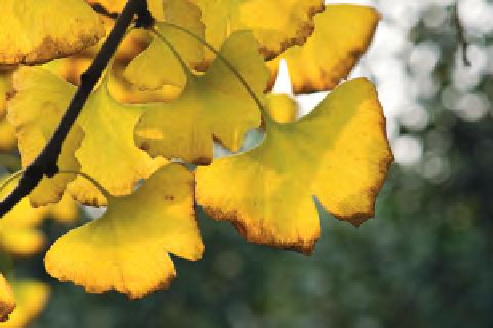Agriculture Reference
In-Depth Information
Monocotyledons and dicotyledons
The angiosperms are split into two main groups
generally known as the
monocotyledons
and the
dicotyledons
. The main differences are given in Table
4.1 and are further described in Chapters 6, 7 and 8.
Monocotyledons
include some important horticultural
families - for example, Poaceae (formerly Graminae)
the grasses and bamboos; Alliaceae, the onions;
bulbous plants such as Liliaceae, which includes
lilies and tulips and Amaryllidaceae which includes
daffodils; Orchidaceae, the orchids and some food
plants such as Musaceae, the bananas (Figure 4.11).
Dicotyledons
have many more families significant to
horticulture, including Magnoliaceae, the magnolias;
Caprifoliaceae, the honeysuckles; Cactaceae, the
cacti; Malvaceae, the mallows; Ranunculaceae,
the buttercups; Theaceae, the teas; Lauraceae,
the laurels; Betulaceae, the birches; Fagaceae, the
beeches; Solanaceae, the potatoes and tomatoes;
Nymphaeaceae, the water lilies; and Crassulaceae, the
stonecrops (Figure 4.12).
Figure 4.10
Ginkgo biloba
leaf in autumn
There are very many important conifers. Some are
major sources of wood or wood pulp, but in the
garden many are valued because of their interesting
plant habits, foliage shapes and colours. The cypress
family Cupressaceae, for example, includes fast-
growing species (e.g. ×
Cuprocyparis leylandii
), which
can be used as windbreaks, and small slow-growing
types very useful for rock gardens (e.g.
Juniperus
procumbens
)
.
The yews are a highly poisonous group
of plants that includes the common yew (
Taxus
baccata
) used in ornamental hedges and mazes.
One division of the gymnosperms is represented
by a single surviving species,
Ginkgo biloba
the
maidenhair tree, which has an unusual slit-leaf shape
and distinctive bright yellow colour in autumn (Figure
4.10). It is a survivor from the Carboniferous era and
fossils are found dating back 270 million years.
The
angiosperms
, or
flowering
plants, encompass
the greatest diversity of plant life with adaptations
for the vast majority of global habitats. There are
estimated to be some 400,000 species of flowering
plant on earth and they represent the most advanced
plant life forms. Angiosperms have the following
characteristics:
X
unique in having fl owers, usually hermaphrodite,
which are pollinated by wind, insects and other
agents and, in many cases, these fl owers are
highly adapted to their specifi c pollinators
X
fl owers produce seeds inside a protective fruit
X
life cycles encompass the full range of ephemerals,
annuals, biennials and perennials
X
can be both herbaceous and woody in structure
X
can be evergreen or deciduous in behaviour
X
occupy the greatest range of habitats.
Many flowering plants are important in gardens, as
crop plants, ornamentals and weeds. Chapters 5 to 10
will focus mainly on the angiosperms.
Table 4.1
Differences between monocotyledonous
and dicotyledonous plants
Monocotyledons
Dicotyledons
One seed leaf (cotyledon)
Two seed leaves (cotyledons)
Parallel veined leaves,
usually alternate and
sword-shaped with
smooth margins
A variety of leaf vein patterns e.g.
reticulate (net) veined and many
different shapes and margins
Vascular bundles in stem
scattered
Vascular tissue (stele) in
the root has many arms
No vascular cambium
Vascular bundles in stem arranged
in rings
Vascular tissue (stele) in the root
with up to seven arms
Vascular cambium
Fibrous root systems
Both fibrous and tap root (primary)
systems
Flower parts usually
in threes or multiples
thereof, also three seed
chambers in fruit
Flower parts usually in fours or
fives or multiples thereof, often
four or five seed chambers in fruit
Small non-woody
herbaceous plants
(except palms and
bamboos)
Both small and large, woody and
herbaceous species with woody
stems showing annual rings and
bark
Further classifications of plants
used in horticulture
Plants can be grouped into other useful categories.
A classification based on their life cycle (ephemerals,
annuals, biennials and perennials) has long been
used by both botanists and growers. Many naturally
perennial plants, such as
Pelargonium zonale
,
Lobelia































